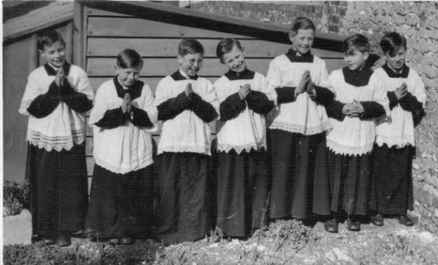Clergy often remark that the Church in America, and certainly in Europe, has reverted to mission territory. Africa and Asia, to whom we sent missionary priests for 300 years, are now supplying priests for American parishes. But not only priests. Here in San Francisco, my Sunday offertory cannot even meet minimal operating expenses; we must ask poorer parishes to fund us. In an effort to jumpstart the parish, we’ve increased our clergy from one priest to two, and we’ve invested in a first-class choral program. Our parish cannot afford these up-front costs, but many friends from former parishes in the Central Valley have sent money to help this “missionary church” in wealthy San Francisco. People do not fill the churches in our cities like they used to, but the faith is growing in this lovely city of St. Francis.
Two months ago I implemented an altar boy policy that reflected the norms of the Catholic Church, particularly the 2001 directive of the Vatican Congregation for Divine Worship regarding female altar servers. This document says that “it will always be very appropriate to follow the noble tradition of having boys serve at the altar.” If girls are invited to serve the Mass, “it would remain important to explain clearly to the faithful the nature of this innovation, lest confusion might be introduced, hampering the development of priestly vocations.” I explained to our school parents the reasons why we are declining the “innovation” of altar girls, pointing to the essential connection between the Church’s male priesthood and the acolytes who assist them in their high priestly office. This beautiful big parish church that we’ve been given to administer needs more members to sustain its irreplaceable mission of word and sacrament in the city. To revive a parish we look first to the sacred liturgy, and among other improvements we wish to strengthen the altar server, lector, and sacristan programs. We consider that developing an all-boys and father-son acolyte program will strengthen the community as it has in many parishes by bonding boys and focusing their efforts on the Mass as sacrifice offered by the priest. We are also training our lectors, and most of them are female, many of them girls from our school.
Still, some members of our church, and of our school in particular, were not happy with the new boys-only acolyte program. Somehow CBS got wind of this unhappiness. The night before the massive Walk for Life in San Francisco, complete with grim anchorpersons and shocked reporters live-on-the-scene, KPIX portrayed our parish as demeaning women in their lead story on the nightly news. Television and newspapers around the country grabbed the story, and a storm of controversy ensued. Of the hundreds of emails and calls from across America, Ireland, England and Australia, almost every one from the San Francisco area was condemnatory, and almost every one from outside our area was supportive.
But it is precisely in the storm of controversy surrounding the altar girl question that I see a first step towards greater faith in our parish and school. For years the school has operated somewhat independently of the parish. Laudably, it needs no funding from the parish; it manages its own staffing; its principal and faculty choose curricula; Masses are planned by teachers and students. It has been many years since parish priests or nuns have taught children at my school. Only 42% of its families are Catholic, many are not attending Mass regularly, and a number of faculty are not Catholic. I know and love my school principal and faculty, and I am coming to know and love the parents and students, but these are the unfortunate facts. It is precisely in this roiling controversy that parish and school have taken the first step in facing these anomalies. And this is certainly a step toward greater faith, because all of us want the school and parish to flourish, and we know we must make sacrifices to allow God to do this work.
Vatican II (Lumen gentium 25) defines a Catholic as one who exercises “religious submission of will” to the Church’s teaching authority. At the parish level, this simply means trusting your priest. Catholics used to trust their priests, and there are various compelling reasons most do not trust them today. But to be Catholic means to regain that trust, both in the Church as mater et magistra and in the local bishop and priest. How can priests serve their flocks as spiritual fathers if their spiritual children do not trust them?
Parish and school are at a turning point. Some will undoubtedly leave the school and some the parish and some will leave the faith (hopefully only for a season) because they cannot bring themselves to trust the Church. But those who face the inconsistencies that have obtained at Star of the Sea for many years will grow deeper in their faith. In a time when churches are empty, every pope, bishop, and priest must be a reformer. I see reform all around me, and reform is the only hope for the Church. This little controversy is a part of the difficult process of pursuing a course that is intended for the good of the entire parish, not only through the encouragement of vocations, but also a purified focus on the ultimate goals of the Church. A friend described this as a difficult but necessary process. May God give us the strength to embrace this constant reform of our faith and practice as Catholic Christians.








 RSS Feed
RSS Feed